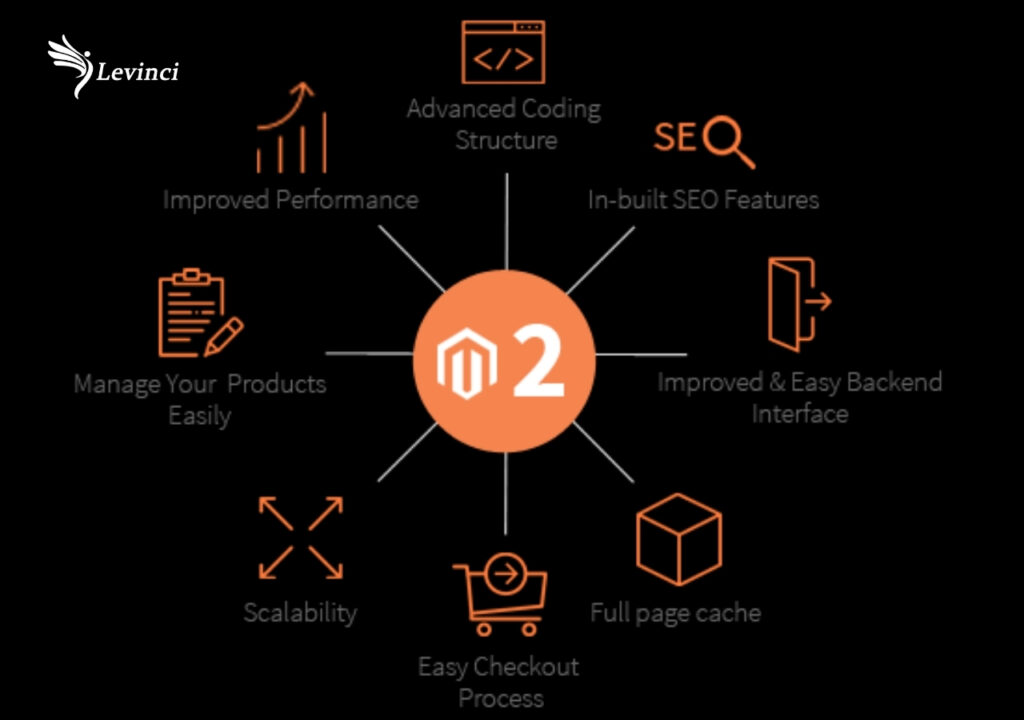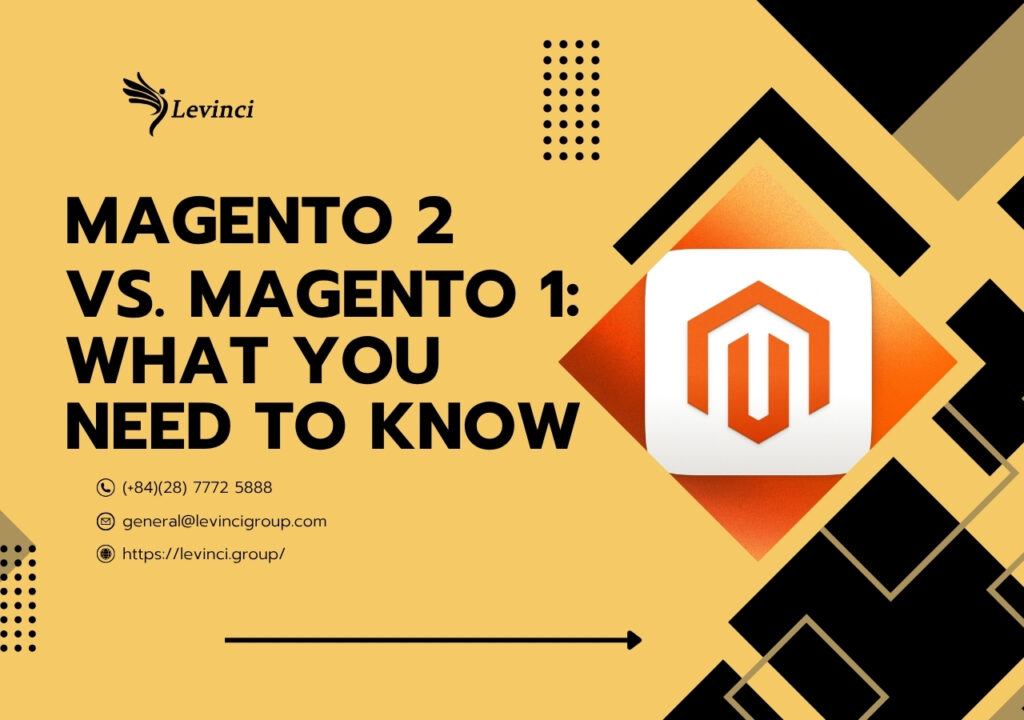In the rapidly evolving world of e-commerce, staying competitive means constantly optimizing your online store. For businesses built on Magento, a critical decision often looms: whether to upgrade from Magento 1 to its successor, Magento 2. While Magento 1 served as a powerful platform for many years, its official end-of-life means it no longer receives crucial security updates or vital support.
Levinci will delve into a comprehensive comparison of Magento 2 vs Magento 1, outlining the significant differences in performance, security, features, and overall capabilities, providing you with the essential knowledge needed to make an informed decision about your e-commerce future.
Magento 1 Overview
Magento 1, introduced in 2008 by Varien Inc., quickly became one of the most influential open-source eCommerce platforms in the market. Built on PHP and the Zend Framework, Magento 1 was designed to provide maximum flexibility and scalability for online businesses of all sizes.
Its architecture allowed developers to create custom solutions tailored to complex business requirements, making it a favorite among enterprise-level merchants and tech-savvy retailers. The platform’s modular design gave developers the ability to extend or modify virtually any aspect of the system, including its themes, checkout process, product catalog, and integrations.
One of Magento 1’s standout features was its multi-store capability, which enabled businesses to manage multiple online storefronts from a single backend, an essential functionality for global retailers operating across different regions and languages.
Additionally, Magento 1 included basic SEO tools that allowed merchants to customize meta tags, manage URL rewrites, and generate sitemaps, helping improve their visibility in search engines. Its large and active developer community contributed thousands of extensions and plugins, making it easier for store owners to integrate third-party services such as payment gateways, shipping providers, ERPs, and CRMs.

One of Magento 1’s standout features was its multi-store capability
However, as the eCommerce landscape evolved, Magento 1 began to show its age. Performance limitations became more evident, particularly for larger stores with heavy traffic or complex product catalogs. The admin interface, while functional, lacked the modern usability standards expected by today’s businesses and often required additional customization to be efficient. Security also became a growing concern, especially as the architecture became outdated and vulnerabilities more difficult to patch reliably.
A major turning point came when Adobe, which acquired Magento in 2018, officially announced the end of support for Magento 1 as of June 30, 2020. This meant no more official updates, security patches, or quality fixes, significantly increasing the risk of compliance issues and exposure to security threats for stores that remained on the platform.
Despite these challenges, many businesses hesitated to migrate due to the high cost, complexity, and time required to rebuild their stores on a new platform. As a result, Magento 1 remains in use by some merchants today, although it is widely considered legacy software with limited long-term viability.
Magento 2 Overview
Magento 2, officially released in November 2015, was developed as a complete overhaul of the original Magento 1 platform. Rather than being a simple upgrade, Magento 2 was a ground-up re-architecture designed to address the performance, scalability, and usability limitations of its predecessor.
Built using modern technologies such as PHP 7+, HTML5, CSS3, RequireJS, and the latest MySQL versions, Magento 2 was engineered to meet the needs of today’s fast-paced, mobile-first eCommerce environment.
One of the most notable improvements in Magento 2 is its dramatically enhanced performance. The platform offers faster page load times, improved server response, and more efficient use of caching with full-page cache support built into both Community and Enterprise (now Adobe Commerce) editions.
Magento 2 also delivers significantly improved scalability, allowing merchants to support higher product volumes, larger user bases, and more complex catalogs without sacrificing performance or stability. This makes it an ideal solution for growing businesses and enterprise-level brands that require a platform capable of handling high traffic and sales volume.

One of the most notable improvements in Magento 2 is its dramatically enhanced performance
Key Differences Between Magento 1 and Magento 2
Navigating the landscape of e-commerce platforms often involves weighing the merits of different solutions, and for many businesses, this historically centered on the choice between Magento 1 and its successor, Magento 2.
Understanding the core distinctions between these two versions is crucial for any business contemplating their e-commerce future, especially given that Magento 1 officially reached its End of Life (EOL) on June 30, 2020. This means it no longer receives official security patches or support from Adobe, rendering it a risky and outdated choice for modern online stores.
Here’s a detailed breakdown of the key differences that set Magento 1 and Magento 2 apart:
1. Architecture and technology stack: Magento 1 was built on an older architectural framework, primarily utilizing PHP 5.x and a more traditional MVC (Model-View-Controller) structure. While robust for its time, this architecture became less efficient for modern web development.
Magento 2, by contrast, is engineered with a modern, modular, and object-oriented architecture, leveraging PHP 7.x (and later, PHP 8.x) and adopting a Model-View-ViewModel (MVVM) pattern. It integrates contemporary technologies like HTML5, CSS3, RequireJS, and Knockout.js for a more dynamic and responsive frontend.
The inclusion of Composer for dependency management and support for technologies like Varnish Cache and Redis out-of-the-box reflects its commitment to a cutting-edge, high-performance environment. This fundamental shift in its technological foundation is the bedrock for many of Magento 2’s subsequent improvements.
2. Performance and speed: This is arguably one of the most significant disparities. Magento 1, due to its older architecture and less optimized caching mechanisms, was often criticized for its slow page load speeds, especially for stores with large product catalogs or high traffic. This could lead to a frustrating user experience and negatively impact SEO.
Magento 2 was designed with performance as a core priority. It features built-in Full Page Caching (FPC) for both Community (now Open Source) and Commerce editions, native integration with Varnish Cache, and optimized database indexing. These improvements result in significantly faster page load times, quicker add-to-cart processes, and a smoother checkout experience, translating to better conversion rates and improved search engine rankings. It can handle a far greater volume of orders and products per hour than its predecessor.

Magento 2 was designed with performance as a core priority
3. Security: With Magento 1 reaching its end-of-life, the most critical difference lies in security. Magento 1 no longer receives official security patches or bug fixes from Adobe. This leaves stores running on Magento 1 highly vulnerable to cyberattacks, data breaches, and non-compliance with essential standards like PCI DSS, which can lead to hefty fines and a catastrophic loss of customer trust.
Magento 2, on the other hand, receives regular security updates, includes stronger hashing algorithms for passwords (like SHA-256), supports two-factor authentication for admin access, and offers better overall protection against common web vulnerabilities. Adobe’s ongoing commitment to security makes Magento 2 a far more secure and compliant platform.
4. Admin interface and user experience: The backend admin panel of Magento 1 was functional but often described as clunky, unintuitive, and difficult to navigate, particularly for non-technical users. Managing products, orders, and content could be a cumbersome and time-consuming task.
Magento 2 boasts a completely redesigned, modern, and highly intuitive admin interface. Its dashboard provides a clear overview of key business metrics (sales, orders, average order value), and streamlined workflows make product creation, order management, and content updates much more efficient. This improved usability reduces the learning curve for merchants and enhances operational efficiency.
5. Checkout process: Magento 1’s multi-step checkout process was a notorious point of friction, often leading to high cart abandonment rates due to its complexity and excessive clicks. Magento 2 drastically simplifies this, reducing the checkout to a streamlined two-step process (shipping and payment). This simplified flow, coupled with better responsiveness and guest checkout options, significantly improves the conversion funnel and enhances the overall customer experience.
6. Mobile responsiveness: When Magento 1 was developed, mobile commerce was nascent. While responsive themes could be implemented, they were often third-party solutions. Magento 2 was built with a mobile-first philosophy. Its default themes are inherently responsive, ensuring an optimal shopping experience across all devices, from desktops to smartphones and tablets. This is crucial for today’s mobile-dominant shopping landscape and also positively impacts SEO, as mobile-friendliness is a key ranking factor.
7. Extension compatibility and development: Magento 1 suffered from frequent extension conflicts, where multiple third-party modules trying to override the same core functionality could lead to broken features or system instability, requiring complex and costly manual fixes. Magento 2 introduces a plugin-based architecture that allows for code customization without directly overwriting core files.
This significantly reduces extension conflicts, simplifies module installation and updates, and makes the development process more modular and efficient. While Magento 1 had a vast array of extensions, many are now outdated and unsupported, whereas the Magento Marketplace for M2 continues to grow with new, compatible, and supported modules.
8. Search Engine Optimization (SEO): While Magento 1 offered basic SEO features, Magento 2 comes with more advanced built-in SEO capabilities. This includes native support for canonical tags to prevent duplicate content issues, improved rich snippets for better search result visibility, enhanced meta tag functionality, and the aforementioned mobile-friendliness and faster loading times, all of which are critical ranking factors in modern SEO. Magento 2 provides a more robust foundation for achieving higher search engine rankings.

Magento 2 comes with more advanced built-in SEO capabilities
When should you upgrade?
Deciding when to upgrade to Magento 2 is a strategic choice that depends on several factors involving your current technology stack, business growth goals, and SEO priorities. Magento 1, despite being a powerful platform in its time, reached its official end of life in June 2020. This means it no longer receives critical security patches, updates, or support from Adobe. Continuing to run your store on Magento 1 after this date exposes you to significant security risks. If your store remains on Magento 1, the most pressing reason to upgrade is simply to maintain a secure environment for your customers and protect your business reputation.
Performance is another key reason to consider the timing of your upgrade. Magento 1’s architecture, while flexible, is increasingly outdated compared to Magento 2’s modern technology stack. If your store suffers from slow page loads, high server response times, or sluggish checkout experiences, these issues directly hurt user satisfaction and your search engine rankings. Since Google’s algorithms increasingly emphasize page speed and mobile usability, an upgrade to Magento 2’s faster, more efficient infrastructure can provide a crucial SEO boost.
From a business operations perspective, your upgrade timeline should also align with your growth and expansion plans. Magento 2 is built to scale more efficiently, supporting larger catalogs, higher traffic volumes, and advanced integrations with third-party systems. If your store is growing or you foresee the need to implement new features or complex workflows, migrating sooner rather than later will future-proof your platform. Delaying the upgrade can lead to technical debt, making later transitions more costly and risky.

Performance is another key reason to consider the timing of your upgrade
SEO considerations also play a vital role in determining when to upgrade. Magento 2 offers built-in SEO improvements such as better URL management, canonical tags, schema markup, and improved metadata handling. Furthermore, its mobile-responsive design and faster load times align with Google’s core web vitals, enhancing your site’s visibility and organic traffic potential. If your current Magento 1 store is struggling to maintain or improve rankings, an upgrade can act as a catalyst for SEO revitalization.
On the flip side, the upgrade should be carefully timed to ensure business continuity. For example, it is wise to avoid upgrading during peak sales seasons like Black Friday or the holiday period, as these times carry high revenue risks should technical issues arise. Instead, schedule your upgrade during a quieter period and after thorough testing in a staging environment to minimize downtime and prevent SEO disruptions.
Finally, the decision to upgrade depends heavily on your available resources. Magento 2 requires a more modern hosting environment and specialized technical expertise to migrate effectively, rebuild custom themes, and reconfigure extensions. If you are prepared with a skilled development team and a solid migration plan, this signals a good moment to proceed. Conversely, if these resources are lacking, it might be necessary to first invest in building your technical capacity or securing external help before undertaking the migration.
Conclusion
The debate between Magento 2 and Magento 1 is, for most businesses, no longer a matter of preference but one of necessity and future-proofing. With Magento 1 officially past its end-of-life since June 2020, continuing to operate on the legacy platform exposes your business to significant security vulnerabilities, compliance risks, and an inability to leverage the latest e-commerce innovations.
Magento 2, in contrast, offers a robust, secure, and highly performant foundation designed for the demands of modern online retail. While the upgrade process can be a significant undertaking, the long-term benefits, from superior speed and user experience to enhanced security and scalability, far outweigh the challenges.
Ultimately, migrating to Magento 2 isn’t just an upgrade; it’s a strategic investment essential for sustained growth, competitive advantage, and delivering an exceptional experience to your customers in today’s dynamic digital landscape.

